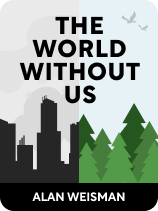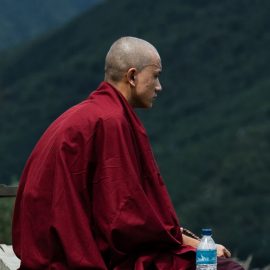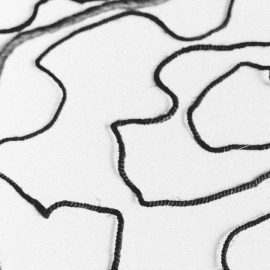

This article is an excerpt from the Shortform book guide to "The World Without Us" by Alan Weisman. Shortform has the world's best summaries and analyses of books you should be reading.
Like this article? Sign up for a free trial here.
How permanent are the changes we’ve made to our planet? Have we left scars that will never heal, or is nature resilient enough to erase any damage we’ve done?
The World Without Us by Alan Weisman is a thought experiment that’s designed to answer those questions. He contemplates the world before people and speculates what the world would be like if the human race disappeared.
Keep reading for an overview of this book, and discover Weisman’s conclusions for his thought experiment.
The World Without Us by Alan Weisman
The human race has left an indelible mark on the planet. We’ve built cities and farms, redirected rivers, tunneled through mountains, and driven species to extinction. In many places, we’ve reshaped entire ecosystems, sometimes through carelessness and sometimes by design.
The World Without Us by Alan Weisman was published in 2007. Weisman, a science journalist, presents the following thought experiment: What would happen if the human race vanished overnight? What impacts, positive or negative, would our disappearance have on the world? He concludes that, in many ways, nature would recover, and the signs that our species had existed at all would eventually be all but impossible to recognize. However, the world that exists after us would be significantly different than the one that came before.
Weisman is an award-winning author whose work has appeared in The New York Times, Los Angeles Times, The Atlantic, Audubon, and Harper’s Magazine. His goal in writing The World Without Us is to address humanity’s environmental impact without pointing the finger of blame at his readers, but rather to encourage people to imagine a world in which nature is allowed to flourish. He arrives there through the science-fictional conceit of a sudden mass human extinction, but he suggests that the greener world he depicts is one that we can work toward while maintaining a sustainable presence on the planet.
In this guide, we’ll look at Weisman’s portrait of the Earth in three stages—the past, the present, and the future. We’ll examine the footprint the human race has left on our world through farming, industry, and the infrastructure of civilization, and we’ll chronicle what Weisman claims will happen if humanity’s presence is suddenly erased, but with all of our buildings, roads, and cities left intact.
The Pristine Earth
Our story begins long before the advent of human civilization. The Earth of the last few hundred million years was a world of lush forests, seas brimming with life, and giant creatures that wandered the land. Weisman describes the primeval world, with ages of warmth punctuated by periods of glaciation and sudden mass extinction events, until humanity emerged from our African cradle and spread to every continent on the planet.
The seas are the source of all life on Earth and are home to the true rulers of the world—the microbial life that existed for eons before larger plants and animals evolved, and will be here long after the rest of us die out.
The microbes form the basis of the ecosystem. The land, for hundreds of millions of years, was dominated by woodlands and savannahs that supported a wide diversity of species. Nevertheless, Weisman points out that the pre-human past wasn’t an era of Edenic bliss. The geologic record shows a history of worldwide extinctions, the worst of which occurred 250 million years ago at the end of the Permian period when 90% of all species died out.
After each extinction event, life has rebounded and evolved in new directions. Millions of years after the Permian extinction, the age of the dinosaurs began. Once they were gone, other giant creatures such as mammoths, ground sloths, and saber-toothed tigers roamed and ruled the wild. More frequent than mass extinction events are the planet’s ice ages, when glaciers advance, habitats shrink, and forests go into retreat. Weisman says that it was probably during one of these ice ages that our pre-human ancestors were forced out of the trees to look for food on the ground. In order to adapt, we learned to walk upright, use tools, and look for more fertile hunting grounds.
Moving outward from the African savannahs, our ancestors spread across Asia and Europe, and then across now-submerged land into Australia and the Americas. In the not-too-distant geologic past, North America was home to more giant species than are found in present-day Africa. However, 13,000 years ago, the majority of American megafauna went extinct. Many historians attribute this die-off to the arrival of the prehistoric Clovis culture, a wave of ancient hunter-gatherers known for their distinctive spearheads ideal for killing large game. Weisman argues that large mammals survived in Africa and not in America because African animals evolved in concert with humans and learned to be wary in ways that American wildlife didn’t.
Humanity’s Footprint
Weisman discusses many imprints the human race has made as we’ve restructured the natural landscape to suit our own needs.
Agriculture
While our lives as hunter-gatherers had an impact on the wild, we truly began to reshape the world when we first learned how to farm. While agriculture has provided great benefits to the human species, freeing people from the constant hunt for food, it’s had a growing detrimental impact on the habitats of many other species, both plant and animal. Weisman tells of how the effects of farming have altered the landscape of the Old World and the New, and how modern farming practices using fertilizer and genetic modification, while drawing more produce from the soil than older methods, have had unintended consequences.
Farming begins with the clearing of land. Soil samples taken in Africa recount a history of agricultural deforestation reaching as far back as the Stone Age. Weisman writes that in a case of colossal bad timing, farming and cattle grazing developed in East Africa just as a shift in climate made the region drier, resulting in accelerated desertification, enlarging the Sahara at an artificial rate. Over 4,000 years ago, the forests of Europe were dealt a blow by farming, while 1,000 years ago the forests of central North America were cleared by the Mississippian culture to make way for the maize crops that supported their cities.
Now, farms and ranches cover a third of the world’s land, while producing more food than ever before. In the 1800s, farmers discovered that adding nitrogen and phosphate to the soil makes plants grow faster and larger. Unfortunately, it also reduces biodiversity by allowing a handful of crops to outcompete all other species. In the 20th century, farmers began using pesticides and added zinc and copper to animal feed to make livestock healthier. These excess metals are then passed into the soil via excrement. The result is an increase in man-made chemicals that drain from farms into streams, ponds, and rivers. Once there, the fertilizers let weeds and algae bloom out of control, removing oxygen from the water so that fish and other species die out.
In even more recent years, farmers have been planting genetically modified organisms (GMOs) that produce higher yields and are resistant to disease and pesticides. Some GMO crops can be highly invasive if their pollen and seeds get loose in the wild. Other GMOs are designed to be sterile—they can’t reproduce without human intervention. These crops, if left untended, can die out and leave behind barren plots of soil that can take decades to recover. GMOs let farms feed larger populations without using up more land, but Weisman says that it’s too soon to know the full ecological impact of replacing naturally adapted species with those created by humans.
Cities and Power
In the modern world, farms primarily exist to feed our growing urban, technological society. That society is maintained by a network of physical connectivity, both for transportation and power, that stretches around the globe like a web and requires constant maintenance in order to function. Weisman talks about how our cities have altered the natural landscape, how our electrical infrastructure acts as a danger to wildlife, and how the places where our energy is produced are potential time bombs for the environment.
Weisman writes that sprawling modern cities completely obscure the original landscape on which they were built. In most large cities, what greenery exists is largely in the form of invasive ornamental plants that don’t feed what native ecosystem is left. Instead, the city’s new ecosystem is dominated by species that rely on us (and our trash) to survive—rats, cockroaches, and the like.
Cities, towns, and modern farms all rely on electricity to function, connected by thousands of towers supporting millions of kilometers of power lines worldwide. While these lines are the lifeblood of technology, Weisman says they’re a threat to many animal species, especially birds. With forests cleared for farms and cities, birds turn to electrical towers as places to perch and nest. The lights and magnetic fields around transmission towers confuse birds’ sense of navigation, and those with large wingspans such as eagles and condors are particularly vulnerable to electrocution if their wings brush two power lines at once, completing a circuit with their bodies. Some species’ numbers have fallen as much as two-thirds of their prior population.
All of our power comes from a source, whether it’s the electricity that powers our cities or the fuel that drives our transportation systems. Weisman highlights two types of power sources as examples of man-made dangers to both the present and the future. The first are nuclear power plants, of which there are more than 400 in the world. The second are the petrochemical refineries that refine oil and gas into fuel for cars, airplanes, and ships, as well as into a variety of other industrial products. All of these plants and refineries work with highly volatile materials and require constant human supervision to maintain them and avoid catastrophic failures.
Waste
What the human race builds is not our most lasting legacy, however, since nothing that we create can last—at least not in its intended form. For all of our history, humanity has generated waste. But, in the current age, we’ve reached a point where the things we created don’t simply fade away after they’ve been used and tossed aside. Weisman discusses several forms of long-lasting waste that accumulate and persist as a result of our modern lifestyles, including plastic, airborne chemicals, and radioactive material.
Petroleum-based plastics have been with us for less than a century, and as much as they’ve revolutionized the consumer and industrial landscape, they’re already affecting the natural world. Though plastic only makes up 20% of what’s in landfills, a great deal of plastic washes out to sea, where it collects in enormous oceanic regions such as the Great Pacific Garbage Patch. Weisman says the problem is that plastic doesn’t truly degrade—it breaks down, but only into smaller pieces of plastic, and as it grows smaller it becomes even more dangerous. Plastic has been found clogging the digestive tracts of countless sea creatures and birds, and smaller plastic particles can be ingested and kill creatures even further down the food chain.
As we’ve polluted the oceans, so we also pollute the air. The primary contaminant that people are concerned with today is simple carbon dioxide, the driving contributor to global warming and climate change, but it’s not the only one of concern. Another relic of the past century is CFCs (chlorofluorocarbon gasses), which were introduced as coolants in the 1930s and had many other home and industrial uses. Since the 1980s, we’ve known that CFCs deplete the atmosphere’s ozone layer, exposing the Earth to harmful ultraviolet rays. Even though the production of CFCs has been widely curtailed, and the damage to the ozone layer has slowed, there are still vast amounts of CFCs still in use or in landfills, waiting to leak into the atmosphere.
Weisman argues that the deadliest byproduct of the modern era is our growing stock of radioactive waste and the difficulty of safely storing it so that nature and future generations are protected. At present, there is no permanent storage for the spent fuel rods from nuclear reactors—most power plants store them on-site in huge cooling pools before sealing them in steel and concrete drums. Most nuclear waste is of a different sort—machine parts, metal casings, protective clothing, and the like—that’s been irradiated by contact with nuclear fuel through power plants, research, or weapons manufacture. Most of this is stored in sealed caverns on land closed off for thousands of years.
A Post-Human World
Given all the ways in which we’ve reshaped the world and continue to affect it every day, Weisman asks a question that’s normally the purview of science fiction writers: What if the human race vanished all at once, but left all our buildings, roads, and power plants intact? We’ll explore Weisman’s answers to this question chronologically, first looking at the immediate effects of humanity’s sudden disappearance, then progressing through the first decades and centuries as the world adjusts to our absence, before finally imagining how the Earth might be thousands of years after we’re gone.
Weisman is clear to point out that this is just a thought experiment—he doesn’t advocate human extinction as a solution to the world’s environmental problems.
Immediate Effects
The first thing that would happen if we disappear is that every system requiring human maintenance would begin to break down. Depending on the system, the effects would be seen in minutes, days, or years, and though some of the results would be beneficial for nature, others would be disastrous. Weisman describes the initial consequences of the absence of human control over our cities, industrial equipment, and power plants.
In our imaginary scenario, the natural world would quickly reclaim every manmade structure. Without repair, water would leak into houses, causing mold and rust that would further weaken their structure. In winter, water pipes would burst, adding to the damage, and as our buildings crumble, plants and animals would find their way inside. Citing the modern example of Cyprus, where towns and resorts were abandoned due to war, Weisman says that, within a handful of years, roofs will have collapsed, trees will grow in houses, and small animals such as birds and rats will have fully turned our homes into theirs. As our houses decay, they become a fire risk, and blazes sparked by lightning may run rampant through our cities, leaving only stone and metal behind.
Weisman points out that immediately upon the disappearance of our species, every piece of technology that requires human operation would cease to function, and those that require constant supervision would soon grind to a halt. Subways in coastal cities would flood without humans to maintain the water pumps that keep them dry. Water would also seep into buildings with no one around to patch roofs and windows. Roads will crack and form potholes, and with no one to repair them, plants will take root and accelerate their natural decay. With no one to maintain them, dams will burst and overflow, turning artificial reservoirs back into valleys.
But all would not be well for the natural world. Weisman explains how disaster would come as our untended chemical and petroleum plants fail in a variety of ways. Though above-ground chemical storage containers are designed with a 20-year lifespan, without humans to perform upkeep on pressure valves and safety systems, the volatile chemicals and stored liquid fuels may leak into the soil as their holding tanks corrode. Before then, if the tanks’ grounding lines rust, lightning strikes would ignite chemical fires that may cascade into explosive chain reactions, releasing clouds of toxic gas into the atmosphere. Such chemical disasters all around the world would kill many plant and animal species while mimicking some effects of a “nuclear winter.”
As for our nuclear legacy, the more than 400 nuclear plants in the world would wreak havoc across wide ranges of the environment. Weisman writes that in the absence of human oversight, the cooling ponds housing used nuclear fuel rods would boil off, igniting radioactive fires. The system of pressure valves within the plants themselves will inevitably break down, triggering meltdowns all across the world. Meltdowns result in steam explosions—not nuclear explosions—but which nevertheless eject radioactive smoke and ash to be carried by the wind across wide swaths of land. The radioactive slag within the reactors would eventually cool, but would still be deadly for thousands of years.
Nature Strikes Back
Despite the initial negative impact humanity’s absence would have on the world, the forces of nature would steadily recoup their losses. Given time, the natural world will erase the relics of our civilization, though the new status quo would be different than before because of human intervention. Forests would reclaim land that was cleared for human use, and wildlife would flourish in our absence, as evidenced by places in the world where humans have already disappeared.
If humans disappeared altogether, forests across the world would bounce back in similar ways, especially in Africa and South America. Without humans adding fertilizer to soil (and its runoff), the dead zones at the mouths of rivers like the Mississippi would once again flourish. The same would be true for coral reefs once humans stop damaging the oceanic balance.
The Great Beyond
Even as the natural world erases the marks of humanity’s existence, echoes of our presence would remain, though greatly diminished over time. In this final section, we’ll take the long view to see what relics of our species would remain after hundreds, thousands, and millions of years.
In the temperate parts of the world, nature would take about 500 years to replace all our cities and structures with forests, but the wilderness of the future would be littered with all the things that nature can’t break down—aluminum, stainless steel, plastic, rubber tires, and all the “forever chemicals” in our consumer products. Cycles of freezing and warming would eventually stress and demolish roads and bridges, though Weisman says that some may last up to 1,000 years. In desert areas, human structures would last longer, but changing weather patterns would eventually bury them under redistributed sand and silt.
Heavily reinforced stone buildings, such as Istanbul’s Hagia Sophia, would last the longest of all, as have the pyramids of the Egyptians and the Maya. Underground dwellings and subway tunnels that don’t lie near water or fault lines would survive much longer than the cities above them—they’re designed not to cave in beneath the weight of all the buildings and earth overhead. However, Weisman asserts that, eventually, a new Ice Age would occur, and whatever remains of cities that are not in the tropics would be crushed under huge sheets of ice. Thanks to global warming, the next Ice Age is delayed, but if we were to vanish today, the world could expect another great freeze in the next 15,000 years.
As discussed earlier, the breakdown of industrial plants and nuclear reactors would release toxic chemicals into the environment, but even the ones we’ve introduced through farming would take a staggering amount of time to be buried out of harm’s way. Weisman reports that the lead we’ve introduced into the soil would last for 35,000 years, while the chromium from stainless steel and auto parts would linger for 70,000 years. The mines from which our metals were pulled from the earth would be another lasting legacy of our species, especially in regions such as Appalachia where entire mountains have been leveled for that purpose.
The Far, Distant Future
The longest-lasting environmental echoes of humanity’s existence would be the carbon we’ve added to the atmosphere, the plastic we’ve added to the soil and oceans, and the plutonium we’ve created for use in nuclear weapons. If we were to stop producing any of those today, it would still take 100,000 years for the oceans to reabsorb our excess carbon dioxide and return the atmosphere to its pre-human levels. The man-made plutonium in the world’s nuclear arsenals will take 250,000 years to decay, outliving our nuclear weapons themselves by the length of a geologic epoch. Though plastic would break down into smaller plastic pieces, it would never decompose unless some future bacteria evolve the ability to eat and digest it.
Apart from the chemical traces we leave behind, would any evidence of the human race last that might let an intelligent future species know that we existed? Weisman says that artifacts made of bronze, copper, silver, or gold would endure if they aren’t crushed or melted. Likewise, ceramics have the potential to last for millions of years if they’re somehow protected. The Great Pyramid of Giza would continue to stand. Though, after, a million years of slow decay, it won’t be recognizable as a human structure. The faces carved on the side of Mt. Rushmore would stare across the plains for 7 million years before erosion blurs their features.
Our final, lasting legacy won’t be what we’ve left on Earth, but what reaches beyond it. Weisman points out that our radio and television signals have been beaming into space since the early 20th century, but while they would continue propagating outward forever, their signal strength would eventually diminish to the point where it’s lost in the cosmic background noise. Our longest-lasting tangible creations would be the spacecraft we’ve sent outside the solar system, such as the Pioneer and Voyager probes. Each of those spacecraft bears a commemorative plaque to let any alien race who comes across it know that our species was here.
Though in the vastness of space, it’s exceedingly unlikely that our probes will ever be found, they’ll exist as an eternal record of humanity’s existence that may last long after our sun itself dies.
Exercise: Consider the Mark You Make on the World
As Weisman makes clear, the world was here long before our arrival and will continue long after we’re gone. However, we do leave an impact, both as a species and as individuals. Reflect on what changes you’ve made to the world and to the lives around you, as well as how your individual choices may carry on into the future.
- Consider the place, family, and culture into which you were born. What circumstances prior to your birth would have the most profound impact on your childhood? What events in society and your immediate family set the stage for the path you would later take in life?
- Name one or more positive actions you’ve taken in your life that impacted your family, your job, or your community. How many people do you think were affected? Was anyone else’s life significantly changed by what you did?
- Imagine the lives of the people around you 10 years after you’re gone. What lasting legacy will remain of your presence, whether or not people are aware? What one thing that you’ve created or changed do you think will continue the longest?

———End of Preview———
Like what you just read? Read the rest of the world's best book summary and analysis of Alan Weisman's "The World Without Us" at Shortform.
Here's what you'll find in our full The World Without Us summary:
- What would happen to Earth if the human race disappeared
- How the planet would benefit from a human extinction
- What the immediate vs. long-term effects would look like






